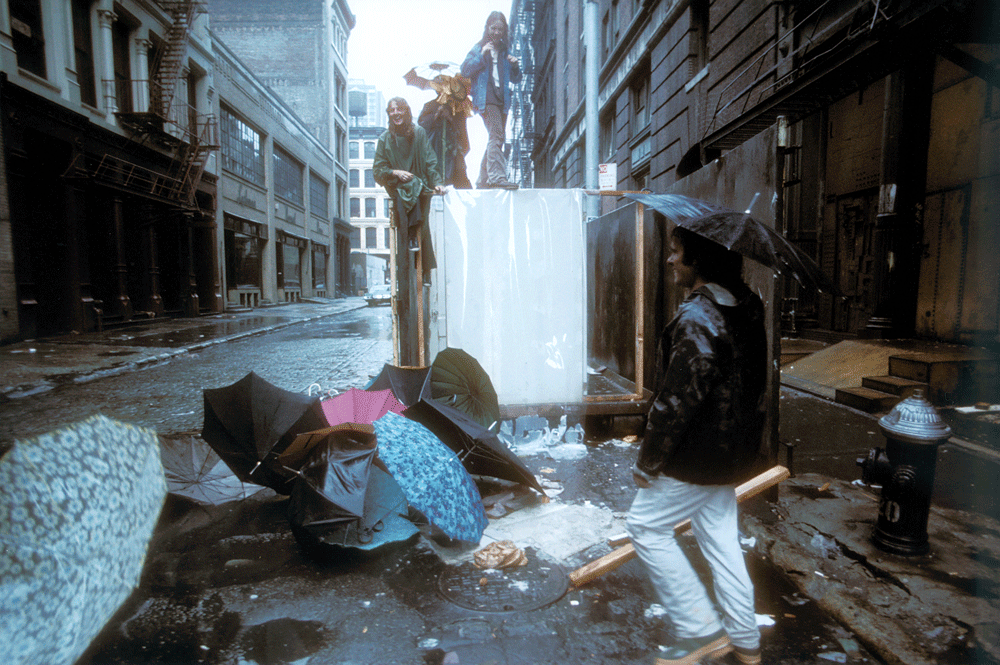112 Greene Street
David Zwirner Gallery & Salomon Contemporary
David Zwirner Gallery & Salomon Contemporary

We are by now comfortable enough with blue-chip galleries digging into their capacious pockets to produce shows that lesser-funded arts organizations (read: museums) would envy, so it almost comes as a surprise when we happen upon gallery shows which look like they should augur larger museum exhibitions. But this was the case when David Zwirner Gallery and Salomon Contemporary staged simultaneous shows devoted to the gallery-cum-laboratory 112 Greene Street in SoHo, New York. Depending on your view, these exhibitions were either complementary or competing, but whether they were taken separately or in aggregate, what was clearest was that the examination of this trailblazing alternative space is only in its initial stages.
Begun in 1970 and helmed by the artist Jeffrey Lew with the help of Alan Saret and Gordon Matta-Clark, 112 Greene Street was housed in the cavernous ground floor and unfinished basement of Lew’s studio building. From the beginning, the space existed in a state of effulgent creative anarchy: the doors were open at all hours, allowing a nascent community of local artists to come and go as they pleased, and to use the space as they saw fit – to saw holes in the floor, stage impromptu performances and generally transform even the darkest basement corners into staging grounds for artistic experimentation. This openness was a timely and practical rejoinder to the rather staid structures of institutional artistic space in New York at the time, which were in the process of undergoing vigorous critique from grassroots organizations such as the Art Workers‘ Coalition. It had the added benefit of providing excellent incubating conditions for process-orientated post-minimalist practices. Rapidly, 112 Greene Street became a kind of artistic crucible, in which like-minds came together to tinker, invent and, perhaps most crucially, to fail and be allowed their failure.
Of all the scores of artists who would come to show their work there, no one was more emblematic of space’s aesthetic than Matta-Clark. It was not surprising, then, that he should be given a central role in ‘112 Greene Street: The Early Years (1970–1974)’ at David Zwirner, which was curated by Jessamyn Fiore, daughter of Matta-Clark’s widow Jane Crawford and author of a forthcoming collection of interviews with those involved in the space’s early years. By my rough calculation, almost two-thirds of the show was devoted to Matta-Clark’s works, leaving the rest of the artists in the show – Tina Girouard, Suzanne Harris, Larry Miller, Richard Nonas, Alan Saret, Richard Serra and Rachel Wood– seeming like something of a supporting cast. Given 112 Greene Street’s aspiration to be a non-hierarchical space of collaboration this hardly seemed appropriate. However, the inclusion of lesser-seen works and documents such as Matta-Clark’s hand-coloured photographs of graffiti on the sides of New York City subway cars, and images of a heartbreakingly beautiful early work in which he planted a cherry tree in the basement on New Years Day 1971 and coaxed it into flower with the use of heat lamps, made this skewed presentation forgivable. Other remarkable works, such as the video documentation of Harris’s strangely sinister dancing machine, Saret’s huddled spindles of wire mesh and Miller’s droll sculpture that consisted of fresh carrots lashed together in a larger, carrot-shaped bundle that rotted away on the gallery floor, served to adumbrate the contours of some of the ideas and practices that intermingled with Matta-Clark’s.
Over at Salomon Contemporary the artist Ned Smyth, who himself showed at 112 Greene Street in the early years, made an attempt to sate a small amount of the curiosity stirred up by the Zwirner show by presenting a more democratic cross-section of the denizens of the 1970s SoHo scene under the title ‘112 Greene Street: A Nexus of Ideas in the Early ’70s’. Featuring the work of a number of artists absent from the Zwirner show, who were nevertheless semi-regular fixtures of the Greene Street space – such as Alice Aycock, Bill Beckley, Joan Jonas, Dickie Landry and George Trakas, as well as artists whose careers intersected with the space only briefly, like Louise Bourgeois and Carolee Schneemann – Smyth’s exhibition had the air of a serious (though small) historical survey, complete with a wall of archival images documenting the tumultuous, exuberant life in the space. Highlights included Bill Beckley’s hilarious Silent Ping Pong (1972), a diminutive ping-pong table padded with perforated foam, complete with matching paddles, documentation of Alice Aycock’s Sand/Fans (1971), and an updated and reconfigured version of George Trakas’s The Piece That Went Through the Floor (1970), a rough, wood-beamed structure that extended up from the basement via a hole in the gallery’s upper floor, which would eventually become part of the space’s freewheeling mythos. Ultimately, however, both shows fell victim to what is perhaps an insurmountable problem: when dealing with a space that was so inextricably tied to the rough-hewn, ramshackle nature of the building in which it was housed and the riotous energy of the artists working within it, any attempt at historical reification, particularly within the anaesthetizing confines of the white cube, necessarily feels somewhat ossified – a semblance of a lost time that cannot be regained. Perhaps the project of revivifying 112 Greene Street’s legacy simply needs the attention of an intrepid museum curator who is willing to attempt the larger-scale, more in-depth exhibition that these two shows have proved that we need. Or, better yet, perhaps the history of the project could best be revived not by an institution, but through the efforts of a similar group of young New York artists, with a similar sense of an urgent, collective creative endeavour. Good luck finding the real estate.
























